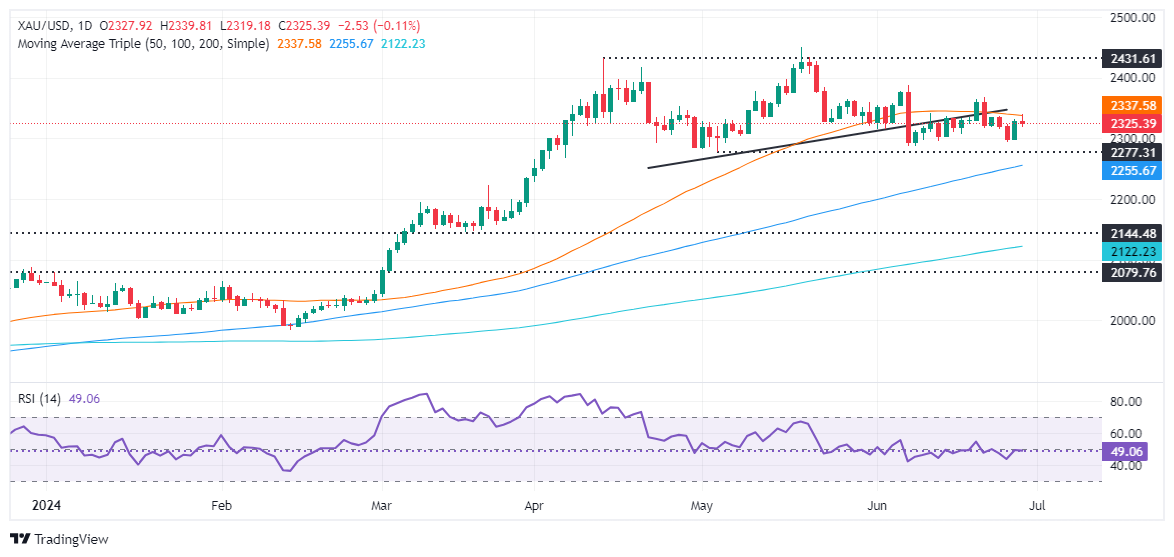- Gold falls from daily highs, pressured by elevated US Treasury yields.
- May US PCE Index meets forecasts, fuels hope for 2024 Fed rate cuts.
- US 10-year yield hits 4.339%, a high since June 12; DXY at 105.80, down 0.08%.
Gold prices retreated during Friday’s session after an inflation report revealed progress in the disinflationary process and raised hopes that the Federal Reserve (Fed) would cut interest rates in 2024. Even though the golden metal jumped and hit a four-day high of $2,339, it retreated somewhat, with XAU/USD trading at $2,324, down 0.12%.
Bullion prices seesawed after the announcement of the US Personal Consumption Expenditures (PCE) Price Index report for May, which was aligned with estimates and painted an optimistic outlook for American consumers hit by higher prices.
Initially, XAU/USD climbed to a four-day high, but as traders digested the data, US Treasury yields climbed and Gold dropped.
The yield in the US 10-year Treasury note is advancing by five and a half basis points, up to 4.339%, the highest level since June 12. Despite this, the Greenback has failed to follow suit yet recovered from reaching daily lows, with the US Dollar Index (DXY) hovering at around 105.80, down 0.08%.
Other data showed that American consumer sentiment improved slightly compared to June’s preliminary reading, which trailed May’s report.
Some Fed officials crossed the newswires, adopting a cautious approach. Richmond’s Fed President Thomas Barkin didn’t provide any hints regarding cutting interest rates, yet commented that monetary policy shows signs of “lagging,” implying the economy eventually will slow down.
His colleague, San Francisco’s Mary Daly, stated that inflation is cooling, that monetary policy is working, and that inflation is expected to hit the Fed’s target by the end of 2025.
Daily digest market movers: Gold price advances, capitalizing on soft US Dollar
- US PCE for May was lower than April’s by 0.3%, coming in at 0% MoM, as expected. Core PCE increased by 0.1% MoM, matching estimates but below the previous reading of 0.3%.
- Fnal reading of US Consumer Sentiment for June was 68.2, down from May’s 69.1 but an improvement over the preliminary reading of 65.8. Inflation expectations remained steady at 3% for both the short and long term.
- According to CME FedWatch Tool, odds for 25-basis-point Fed rate cut in September are at 69%, up from 64% before US PCE release.
- December 2024 fed funds rate futures contract implies Fed will ease policy by just 35 basis points (bps) toward the end of the year.
Technical analysis: Gold price slumps after testing Head-and-Shoulders neckline
Gold remains on the defensive after a Head-and-Shoulders chart pattern emerges, which hints bullion might edge lower. Momentum shows that neither buyers nor sellers are in control, but the Relative Strength Index (RSI) remains tilted bearish.
If XAU/USD drops below $2,300, the next stop would be the May 3 low of $2,277, followed by the March 21 high of $2,222. Further losses lie underneath, with sellers eyeing the Head-and-Shoulders chart pattern objective from $2,170 to $2,160.
Conversely, if Gold reclaims $2,350, that will expose additional key resistance levels like the June 7 cycle high of $2,387, ahead of challenging the $2,400 figure.
Fed FAQs
Monetary policy in the US is shaped by the Federal Reserve (Fed). The Fed has two mandates: to achieve price stability and foster full employment. Its primary tool to achieve these goals is by adjusting interest rates. When prices are rising too quickly and inflation is above the Fed’s 2% target, it raises interest rates, increasing borrowing costs throughout the economy. This results in a stronger US Dollar (USD) as it makes the US a more attractive place for international investors to park their money. When inflation falls below 2% or the Unemployment Rate is too high, the Fed may lower interest rates to encourage borrowing, which weighs on the Greenback.
The Federal Reserve (Fed) holds eight policy meetings a year, where the Federal Open Market Committee (FOMC) assesses economic conditions and makes monetary policy decisions. The FOMC is attended by twelve Fed officials – the seven members of the Board of Governors, the president of the Federal Reserve Bank of New York, and four of the remaining eleven regional Reserve Bank presidents, who serve one-year terms on a rotating basis.
In extreme situations, the Federal Reserve may resort to a policy named Quantitative Easing (QE). QE is the process by which the Fed substantially increases the flow of credit in a stuck financial system. It is a non-standard policy measure used during crises or when inflation is extremely low. It was the Fed’s weapon of choice during the Great Financial Crisis in 2008. It involves the Fed printing more Dollars and using them to buy high grade bonds from financial institutions. QE usually weakens the US Dollar.
Quantitative tightening (QT) is the reverse process of QE, whereby the Federal Reserve stops buying bonds from financial institutions and does not reinvest the principal from the bonds it holds maturing, to purchase new bonds. It is usually positive for the value of the US Dollar.

